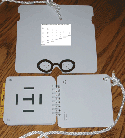Alaska Blind Child Discovery
2021 ABCD Favorites
Home
"What
Should Pediatricians Use / Purchase for "State-of-the-Art" 2021
Vision Screening?"
The American Academy of Pediatrics (AAP) has added to its guidelines for pediatric vision screening a Position Paper recommending Photoscreening for early detection of conditions that lead to treatable blindness due to Amblyopia. The 2017 AAO Amblyopia preferred pratice pattern is very helpful.
The AAP and the AAPOS Vision Screen Committee do NOT recommend merely a single screening
for pre-schoolers, rather it recommends a
series of age-appropriate guidelines (AAP)
combined with appropriate history and physical findings.
In addition to newborn red reflex testing and infant fixation / cover
testing, Bruckner Testing is a useful tool
for an experienced pediatrician. As Kirk in Alaska and Sean
Donahue demonstrated with over 100,000 real community MTI photoscreenings,
specific early toddler photosreening might actually "prevent"
amblyopia in many cases. Carefully interpreted photoscreening and
remote autorefraction in toddlers can identify one of the most important, and occult
amblyopiagenic factors: inability to sufficiently accommodate in one or
both eyes, in various meridia. Pediatricians can now bill for objective photoscreening with CPT 99177 or 99174. In Alaska and Iowa statewide experience,
objective screening works very well in community screening from age 1
to age 7 years and takes only 20-30 seconds per child. Photoscreeners can be modified to work as "Drive-by" when social distancing is prudent.
Please inform yourself of critical issues regarding VALIDATION of Objective and Sensory Amblyopia VISION SCREENING. Your understanding, or lack thereof, can "make" or "break" a vision screening program. Review the table with Research-referenced Screening Instruments.
Objective testing includes remote autorefractors and Photoscreeners. Current models have internal or internet interpretation allowing prompt and valid results. Each photoscreener REQUIRES the selection of instrument referral criteria chosen to maximize sensitivity and specifity for your screening environment. ABCD has validated all the most recent commercially-available models and has the following impressions:
For instant, multi-axial, infrared refractive and strabismus estimates- Plusoptix user-friendly and has the most validation research experience with the best ability to select a SPECIFIC early instrument referral criteria., Adaptica 2WIN recent model has been calibrated by ABCD with autorefraction resembling Retinomax, a unique strabismus "CR"wand and Kaleidos luminance-control tube. Welch Allyn SPOT- wide range of refractive estimates and some emerging validation. Each of these require the patient sit still and focus on the camera for 2-5 seconds. (CPT 99177)
For wiggly and inattentive children, the visible light iScreen has near-instantaneous sequential flash and therefore is best for special needs practices. iScreen requires internet download for computer + expert interpretation (CPT 99174). GoCheckKids has developed valid software to allow a variety of smart phones (Nokia 1020 in the past and iPhone 7+ with flash concentrator and glow box 2019-20) for cost-effective pediatric vision screening by pediatricians and family health providers using either 99177 or 99174.
The Rebion blinq uses novel technology to seek reflected birefringence coming from exactly aligned (foveating) eyes. It may be best at early determination of the most difficult types of amblyopia allowing very early treatment and better chances of success. ABCD has validated the blinq purchasing ours in November 2019 as soon as it was commercially released.
Which is better- photoscreening or acuity screening? BAD QUESTION says ABCD! Rather- which screening should be used at which age? We recommend AAP Guidelines modified with photoscreening age 1-2 years, again at 3-4 years and then Kindergarten entry and developmental delay. Surround, randomized acuity screening with monocularity assured by patching follows. Manifest strabismus should be urgently referred by observant parents teamed up with atuned pediatricians- ABCD only recommends stereo screening for strabismic amblyopia if it is quick and efficient. ABCD considers isolated, small-angle strabismic amblyopia so rare that most tests lack specificity to effectively target this entity- other than Rebiscan.
Subjective testing of acuity can be done
on a few children three years or younger, however the ability of Pediatrician
technicians to do this test well is more age-dependent. Unless we better
educate pediatricians and improve the skills of their technicians, objective
testing will out-perform acuity testing in pre-K. There are some good points about characteristics
of good acuity tests; it is amazing to find how poor quality charts
some "good" pediatricians are using! Another critical point
is assuring monocular testing. This can be assured by patching
the non-tested eye in the majority of children who accept this method.
Special broadly occluding spectacle frames work for finicky patch kids.
Acuity testing can seek a threshold for each eye and refer pre-K unable
to achieve 20/40 or two line difference; this takes about 3-7 minutes
to screen a child. Another good method is to screen only a critical line
of 20/40 for each eye; this takes 2-4 minutes per child. Pediatricians
can, and should, charge for monocular acuity testing using 99173. The recent AAP recommendation to use 20/50 for preschool acuity screening lacks any validation compared to using 20/40; ABCD finds 20/40 a valid screening criteria.
Acuity testing becomes faster, and more efficient in older children but
still MUST assure monocularity. A Nintendo 3DS game called PDI Check can do a quick, fun job of screening monocular Landholt C acuity, stereo and color.
Pediatricians might purchase a computer, wall-mounted, multi-optotype
remotely-operated screening system like eye doctors have in our lanes for over
$3000, or illuminated wall charts for $100-$500, or flip charts for $20-$50.
There are child-friendly computer-game acuity tests that might appeal
to many pediatricians. Consistent critical
line charts can be obtained free online, so no American child should
"go blind" for lack of a chart.
(Financial Disclosure: ABCD received discounted vision screening materials
/ technology from many of the manufacturers mentioned but receives no
direct payment to ABCD workers)
Warmly,
Robert Arnold, MD
Alaska Children's EYE & Strabismus, Anchorage
ABCD History

Kids Eye Disorders
Amblyopia
Vision Screening
Issues
ABCD Clinics
References
Contact ABCD

Photoscreener Videos


